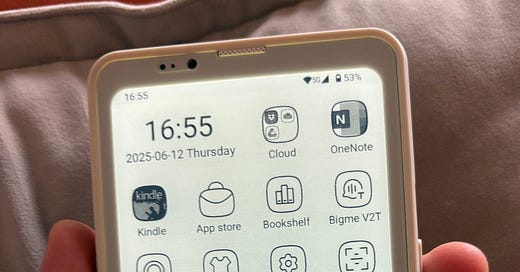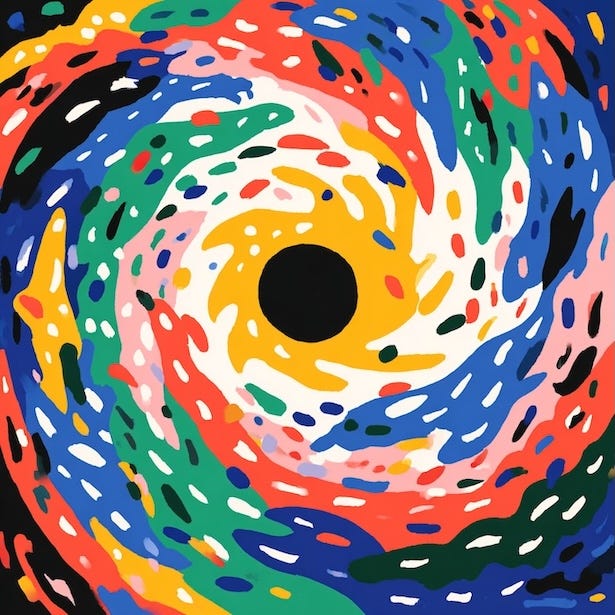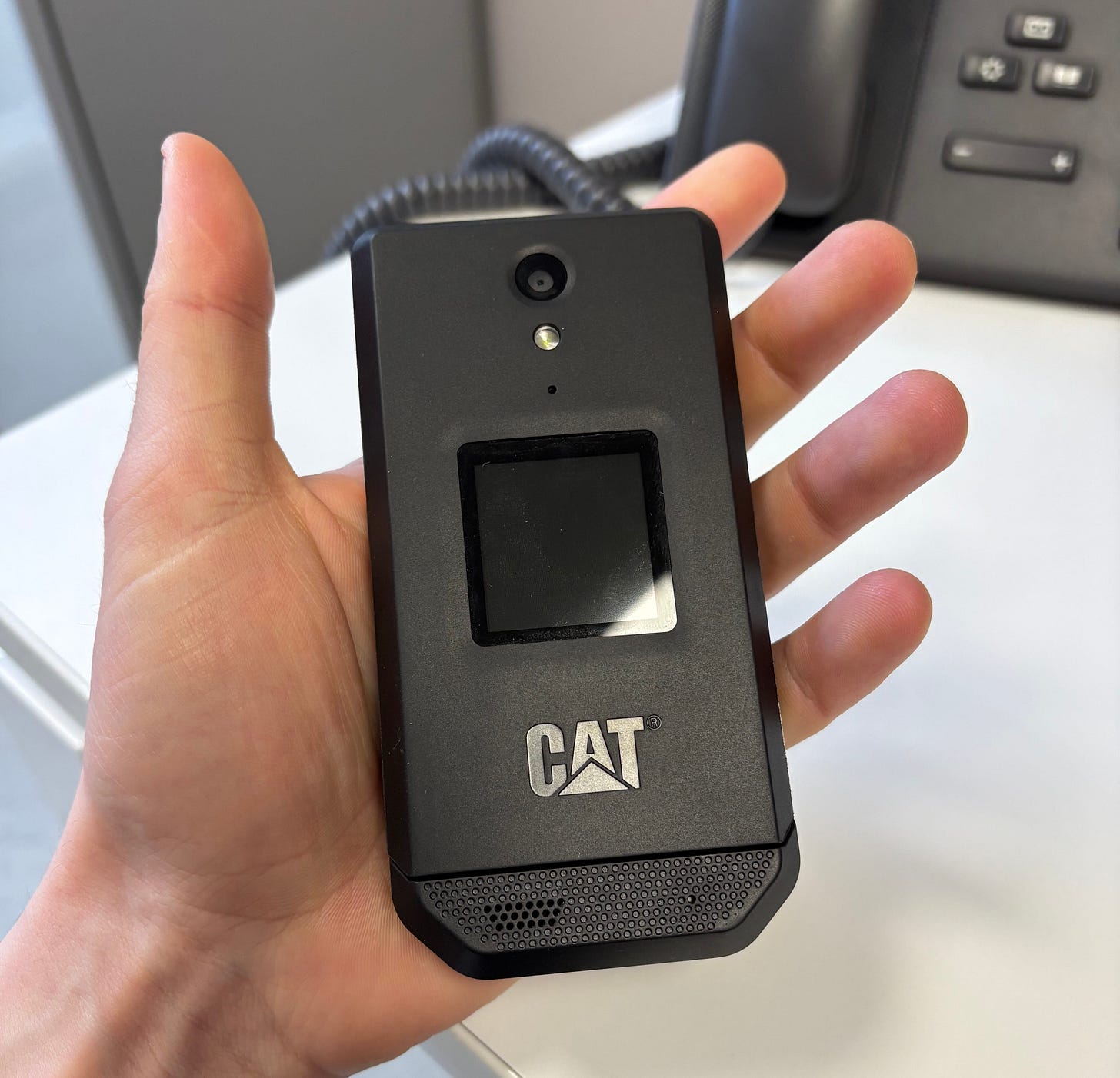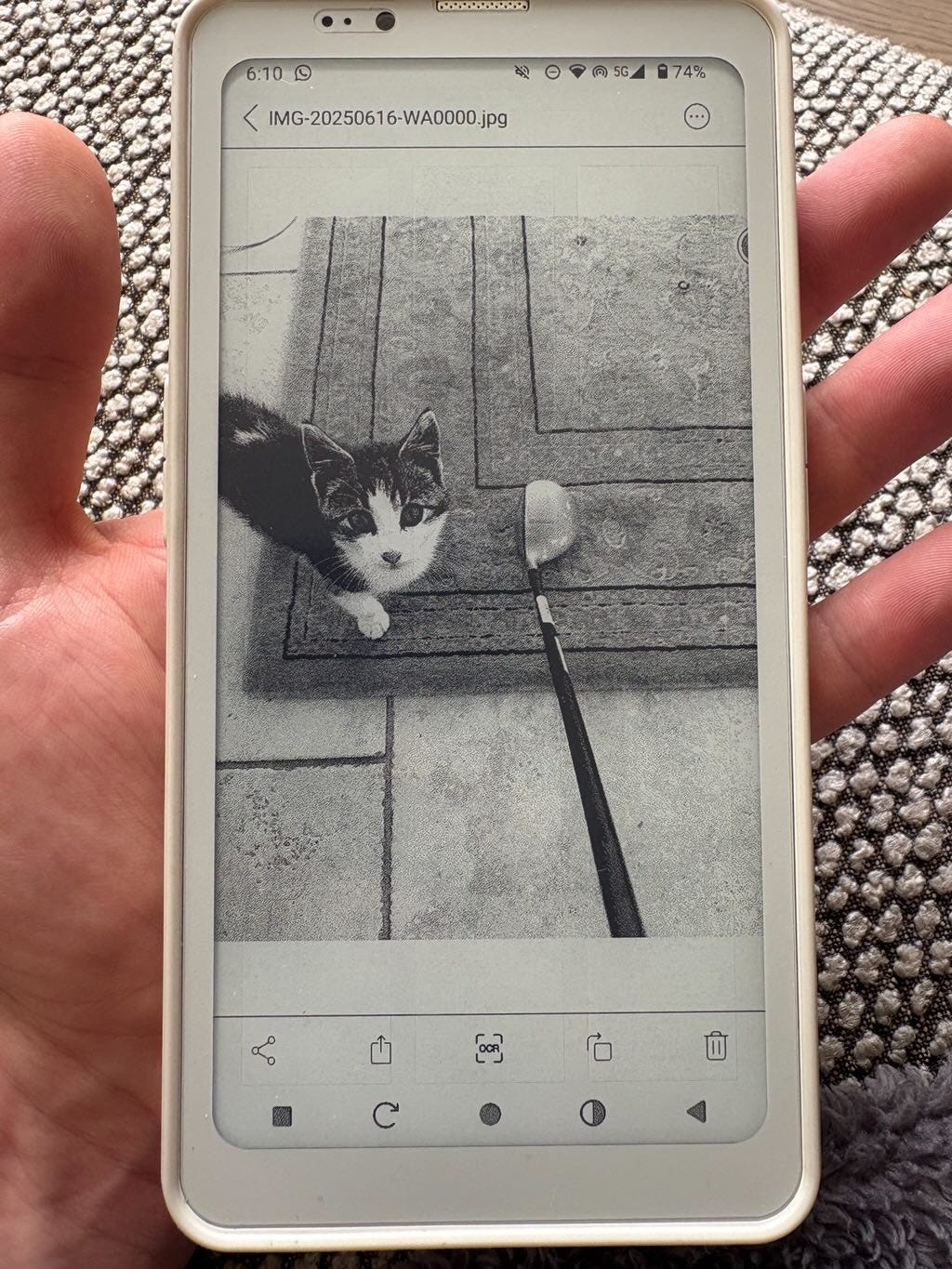Gentle Reader,
I have a strong dislike of my smartphone, but when somebody asked me recently why I had changed it for a greyscale e-ink device, I couldn’t provide a succinct answer.
The influence of my phone on my mood and my nervous system is insidious and yet all-pervasive. A simple two sentence answer would never have captured my feelings about it, so I said that I found it overstimulating, and let the conversation move on.
We all know our phones lure us in to their aura, paralysing our agency and sucking us into a doomscrolling vortex, but that’s not their only effect. They also have quite a paralysing effect when we aren’t using them, because our brain starts to seek dopamine, and it knows that easy, low-hanging stimulation is available from the device in our pocket or on the coffee table.
I hate it. I hate the gravitational pull it has upon me. I hate that I don’t read much at all anymore, as my attention span has been consistently worn down. I don’t like how I reach for my phone while walking, queuing, or standing at bus stops and I don’t like how scrolling has become my default activity if I’m tired or bored.
Socially, I also hate when somebody takes their phone out during a conversation. It breaks the flow of the interaction and, to be honest, I find it rude. Obviously, sometimes you have to check a message but, most of the time, whatever you are looking at can wait until after the conversation. Otherwise, you have prioritised a screen over a human.
How can we escape the vortex?
The brick
There is no one-size fits all solution. This is because the vortex is embroidered within the fabric of our lives, and not just in our phones. It’s easy to throw your phone in the bin and take a vow of technological chastity, until all the two-factor authentification requests come rolling in.
In my first attempt to escape, I bought an old dumbphone, a folding brick made by Caterpillar, a company which also makes construction equipment. It was a big, heavy unit which was clearly designed for building sites.
It had its merits. I liked that it was a flip-phone. After a call, I would flip it closed with a satisfying click. It attracted attention in a way which was funny but also started a debate. But, it also seemed a bit too much like a statement, as if I had strayed too far into the wilds of hipersterism for the sake of it. I felt this before I realised its full limitations.
You see, it just didn’t have enough juice. It had Whatsapp, but the keyboard was so hilariously bad that it was unusable. I actually wanted friction, because I don’t want to spend my time frantically typing and exchanging cat gifs, but sending a text when I really needed to was beyond infuriating.
There were other hurdles. Old phones don’t have NFC, which is what supports the ability to tap your phone to pay for something, but which also is needed for certain membership cards. The fancy gym I go to requires that we tap on our way in. I thought this was great, until the staff told me I could only get in without tapping by giving my name and date of birth at reception, which was fine, but then at the spa at the back of the gym where I like to go (do not judge, gentle reader), you also need to swipe in and there isn’t always somebody there to take your details.
The friction was too much. I had to bring two phones just to get a workout in. At this point, I decided I needed a halfway house: more tech, more capacity, but also hopefully still less stimulating, something that wouldn’t have me reaching for it every five minutes, but could still do a job. I was also inspired by the fact that some people have just gone full Luddite, like writer August Lamm who not only got rid of her smartphone, but also her computer, despite being a writer.
So, I knew it was possible, but I also knew I couldn’t go cold turkey yet.
Enter, the e-ink phone.
E-ink
You know the weird, non-shiny screens that kindles have? They are made from something called e-ink, which is a brand of e-paper, a screentype which tries to simulate real paper. Since my flipping brick didn’t cut the mustard, I bought one of these: a greyscale, e-ink phone (you can have colour e-ink too, like I have on my e-ink tablet – more on that later).
It’s an upgrade on the previous weapon. It has NFC, even though I haven’t got it working yet. It operates on Android, which is a big improvement on whatever garbage the Cat was running, and which also happens to be my personal favourite operating system. This means that you can get nice apps from the Google Play Store, although I am keeping them to a very bare minimum.
The e-ink screen is very nice. A relevant criticism is that you can just put an iPhone on black and white and get almost the same experience, but the devil is in the detail. The e-ink is much more restful on the eyes, and is great for people who want a reading device which also happens to be a phone. Plus, on the iPhone or similar, there’s always the risk you’ll turn those alluring colours back on. Ironically, there’s no point in me showing you the difference between a greyscale iPhone and the e-ink phone, since the screen you are using to assess them will negate the differences.
Is the e-ink screen perfect? No. In fact, I would much prefer if it were colour, even if colour e-ink is not very arresting (that’s the point!). But this is the biggest problem for me at the moment – I have to send and receive photos in greyscale and, to be honest, it’s as good as useless. You can’t enjoy a photograph or get the true sense of it, without colour. Equally, when you send a photograph, you don’t really know what it looks like.
Here’s an example from my phone of a kitten beside a golf club:
Colour is a big deal — I’m sure there will be or maybe there already is a colour e-ink phone. I think it’s probably worth waiting for that, as it’s a big upgrade.
There are other downsides. The phone is guilty of ‘ghosting’ which means that there is a slight delay between input and response. For those of us trained on high-tech devices, this delay is maddening at first, until you get used to it.
It’s also just not as slick. It has facial and fingerprint recognition, but they also have a bit of lag compared to top end phones. Actually, just using this phone really gave me an appreciation for just how incredible a phone like an iPhone is – it is just so fast, so responsive, so quick to navigate from one screen to the next and to find anything you want on it. But that’s a kind of high-speed technological crack cocaine I don’t really need in my life.
The e-ink phone is also just a bit janky. Every now and then, something doesn’t work for absolutely no good reason. Yes, it’s annoying. In those moments, I breathe deep and think of the payoff. It also has randomly cut out in a call twice and I don’t think that was a coincidence either, so we are far from plain sailing.
So, what is the outlook? Are we all destined to leave the fantastic technicolour dreamworld of our vivid phones in favour of pastures new?
I don’t know, but e-paper does seem to be taking off and, if regular and slightly odd Joes like me are interested in using e-paper phones and tablets, then others will be too. This might be just the start.
Still, even if it’s a good change, I see it as part of a journey, a step in the right direction rather than the whole solution. No single device will fix all of our attention and nervous system dysregulation, but the right tool can shape us and bring us closer to our goals.
For now, I admit I still keep my iPhone close by, in case something doesn’t work or I need an app to do something quickly. It’s also handy to have a very good, colour camera to hand, and also it works well as a streaming device for the apple TV. As I plan to wean off it fully in the short term, and I don’t leave it anywhere near my bed. When I wake up, I see my slightly dim and unengaging screen, and I’m more likely to get up out of bed than to look at a screen.
It’s odd to think of a future which is not composed of hyper-real and hyper-vibrant screens, but progress isn’t always shiny and glistening — maybe the future is muted in colour and slightly blurry, but it might still be a better place to inhabit.
Thanks for reading. AI wrote precisely 0% of this article. Click below to subscribe for more.
I also write another fortnightly newsletter called “The Leg Up” which discusses longevity and vitality from a doctor’s perspective. This week’s chapter covers the three pillars which I consider to be the foundations of movement health – the musculoskeletal, metabolic, and motor systems of the body. Subscribe below to make sure you don’t miss it!
Affiliates:
My friend Paul Millerd runs the Pathless Path Community, a cozy online space where we support each other to find ways to live and work in the most authentic way possible.









Thank you for writing this! Always good to see other perspectives on less-addictive smartphone alternatives. I looked into e-ink phones a little while back, but they unfortunately just seemed a little too limiting for my purposes. As you say, the iPhone is a remarkable phone--when used as a tool, not as a social media and entertainment delivery system.
I've personally been having a lot of success with using greyscale on my iPhone. I did worry about the temptation you mentioned of turning colours back on, but I actually find that my phone looks utterly garish when I do that. You don't realize how sickeningly oversaturated the iPhone UI is until you spend several weeks in greyscale mode!
I agree that looking at / taking photos in greyscale is less than ideal (and it's one of the main reasons why I didn't want to buy an e-ink phone), so I set up some shortcuts and automations to force my phone to automatically turn colours back on when I open up Camera / Photos, then turn them off again when I'm not using those apps. Saves a lot of time overall and is much less annoying than manually making the swap every time.
Preach, brother! I bought the Blank Spaces app (https://www.blankspaces.app/) for my iPhone and it's been doing a solid job of keeping me off my phone. Very similar to you, I hate my phone. I hate how it eats up all of my in-between moments and eats up the connection between humans when they're in the same space.
As a way to reclaim my time, I've given myself an internet budget of two hours per day and basically treat my technological life like it's 2005. I still use my phone to call and text and find my way around if needed. Apple Pay is convenient when I forget my wallet (rare). But I've relegated all other activities to my computer and bought a stopwatch to keep myself on track. I have gone over my two hours maybe three times in the past four weeks, but the overall benefits are incredible and my experiment will likely continue indefinitely. Constraints are good.